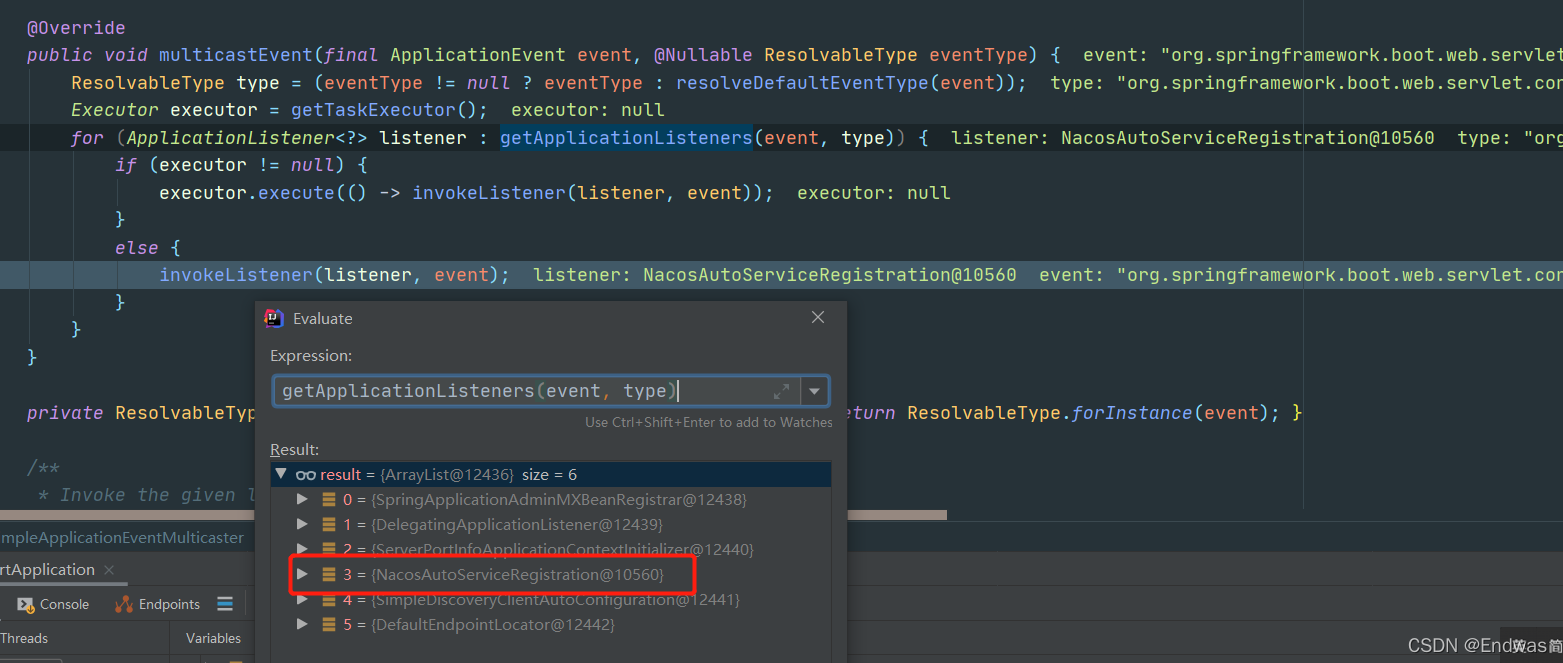nacos我们都知道是微服务中用来做注册中心和配置中心的中间件,本文就来探讨一下Spring Cloud是如何将服务注册到注册中心,而nacos又是如何在上述规范中实现自己代码逻辑的。本文中使用的是nacos作为例子。
过程
我们都知道Spring提供了很多的扩展点,包括在BeanFactory的后置处理器BeanFactoryPostProcessor、在某个Bean创建后的BeanPostProcessor等等。
- 那么服务注册是如何实现的呢?
要解决这个问题,我们先查看Spring中核心代码。
AbstractApplicationContext#refresh()
@Override
public void refresh() throws BeansException, IllegalStateException {
synchronized (this.startupShutdownMonitor) {
// Prepare this context for refreshing.
prepareRefresh();
// Tell the subclass to refresh the internal bean factory.
ConfigurableListableBeanFactory beanFactory = obtainFreshBeanFactory();
// Prepare the bean factory for use in this context.
prepareBeanFactory(beanFactory);
try {
// Allows post-processing of the bean factory in context subclasses.
postProcessBeanFactory(beanFactory);
// Invoke factory processors registered as beans in the context.
invokeBeanFactoryPostProcessors(beanFactory);
// Register bean processors that intercept bean creation.
registerBeanPostProcessors(beanFactory);
// Initialize message source for this context.
initMessageSource();
// Initialize event multicaster for this context.
initApplicationEventMulticaster();
// Initialize other special beans in specific context subclasses.
onRefresh();
// Check for listener beans and register them.
registerListeners();
// Instantiate all remaining (non-lazy-init) singletons.
finishBeanFactoryInitialization(beanFactory);
// Last step: publish corresponding event.
// nacos客户端注册处
finishRefresh();
} catch (BeansException ex) {
if (logger.isWarnEnabled()) {
logger.warn("Exception encountered during context initialization - " +
"cancelling refresh attempt: " + ex);
}
// Destroy already created singletons to avoid dangling resources.
destroyBeans();
// Reset 'active' flag.
cancelRefresh(ex);
// Propagate exception to caller.
throw ex;
}
finally {
// Reset common introspection caches in Spring's core, since we
// might not ever need metadata for singleton beans anymore...
resetCommonCaches();
}
}
}
在整个容器刷新结束阶段,nacos会进行服务注册。那么我们看看在这是如何进行服务注册的。
@Override
public void publishEvent(ApplicationEvent event) {
publishEvent(event, null);
}
首先发布了个事件 ServletWebServerInitializedEvent,这个事件会被所有监听器监听,然后触发。

@Override
public void multicastEvent(final ApplicationEvent event, @Nullable ResolvableType eventType) {
ResolvableType type = (eventType != null ? eventType : resolveDefaultEventType(event));
Executor executor = getTaskExecutor();
for (ApplicationListener<?> listener : getApplicationListeners(event, type)) {
if (executor != null) {
executor.execute(() -> invokeListener(listener, event));
}
else {
invokeListener(listener, event);
}
}
}
- 获取到所有的监听器,逐一调用事件,典型的观察者设计模式。
最后我们发现Nacos往容器中注册了一个监听器 NacosAutoServiceRegistration
这个类实现了ApplicationListener,所以肯定会在监听到ServletWebServerInitializedEvent事件时候,回调onApplicationEvent方法。但他并没有重写onApplicationEvent方法,那么他就是调用了父类的onApplicationEvent方法。
我们可以去看AbstractAutoServiceRegistration中的onApplicationEvent。
/**
* Register the local service with the {@link ServiceRegistry}.
*/
protected void register() {
this.serviceRegistry.register(getRegistration());
}

最后经过端口绑定、判断是否开启服务注册等后,进行向注册中心注册的方法。
// NacosAutoServiceRegistration#register
@Override
protected void register() {
if (!this.registration.getNacosDiscoveryProperties().isRegisterEnabled()) {
log.debug("Registration disabled.");
return;
}
if (this.registration.getPort() < 0) {
this.registration.setPort(getPort().get());
}
super.register();
}
// super.register调用的该处代码AbstractAutoServiceRegistration#register
protected void register() {
this.serviceRegistry.register(getRegistration());
}
以上其实都是Spring Cloud帮助我们封装好的规范,最终我们需要调用
this.serviceRegistry.register(getRegistration());
去进行对应注册操作,而像nacos、erueka则调用对应实现类即可。
2.封装
我们从上文得知,nacos本质就是往容器中放置了一个listener,通过监听到web服务初始化事件ServletWebServerInitializedEvent进而进行注册操作。
那么我们来看看放了什么进入容器、怎么放入容器的
1.自动装配
我们都知道,Spring boot自动装配,通过在jar包中配置spring.factories文件进行。那么我们看看nacos是否也是这样放入自己实现类的。
查看nacos discovery下的META-INF/spring.factories文件
果然发现了自动注册客户端的配置类

我们看看这个配置类,往容器引入了什么类。果然我们发现了上节说到了自动注册组件实现类。
/*
* Copyright 2013-2018 the original author or authors.
*
* Licensed under the Apache License, Version 2.0 (the "License");
* you may not use this file except in compliance with the License.
* You may obtain a copy of the License at
*
* https://www.apache.org/licenses/LICENSE-2.0
*
* Unless required by applicable law or agreed to in writing, software
* distributed under the License is distributed on an "AS IS" BASIS,
* WITHOUT WARRANTIES OR CONDITIONS OF ANY KIND, either express or implied.
* See the License for the specific language governing permissions and
* limitations under the License.
*/
package com.alibaba.cloud.nacos.registry;
// 省略
import *
/**
* @author xiaojing
* @author <a href="mailto:mercyblitz@gmail.com">Mercy</a>
*/
@Configuration(proxyBeanMethods = false)
@EnableConfigurationProperties
@ConditionalOnNacosDiscoveryEnabled
@ConditionalOnProperty(value = "spring.cloud.service-registry.auto-registration.enabled",
matchIfMissing = true)
@AutoConfigureAfter({ AutoServiceRegistrationConfiguration.class,
AutoServiceRegistrationAutoConfiguration.class,
NacosDiscoveryAutoConfiguration.class })
public class NacosServiceRegistryAutoConfiguration {
@Bean
public NacosServiceRegistry nacosServiceRegistry(
NacosDiscoveryProperties nacosDiscoveryProperties) {
return new NacosServiceRegistry(nacosDiscoveryProperties);
}
@Bean
@ConditionalOnBean(AutoServiceRegistrationProperties.class)
public NacosRegistration nacosRegistration(
ObjectProvider<List<NacosRegistrationCustomizer>> registrationCustomizers,
NacosDiscoveryProperties nacosDiscoveryProperties,
ApplicationContext context) {
return new NacosRegistration(registrationCustomizers.getIfAvailable(),
nacosDiscoveryProperties, context);
}
/**
* 注册实例的关键类,通过使用上面NacosServiceRegistry进行NacosRegistration注册
*/
@Bean
@ConditionalOnBean(AutoServiceRegistrationProperties.class)
public NacosAutoServiceRegistration nacosAutoServiceRegistration(
NacosServiceRegistry registry,
AutoServiceRegistrationProperties autoServiceRegistrationProperties,
NacosRegistration registration) {
return new NacosAutoServiceRegistration(registry,
autoServiceRegistrationProperties, registration);
}
}
在创建NacosAutoServiceRegistration 时,传入了NacosServiceRegistry、NacosRegistration。
使得在注册时候调用进行注册。
protected void register() {
this.serviceRegistry.register(getRegistration());
}
3.总结
Spring Cloud服务注册原理,从Spring容器初始化后通过监听器监听,然后进行对应监听器调用进行服务注册,Nacos实现了全套的注册组件,只需引入后配置好地址就可以实现,自动化服务注册功能。























 176
176











 被折叠的 条评论
为什么被折叠?
被折叠的 条评论
为什么被折叠?








